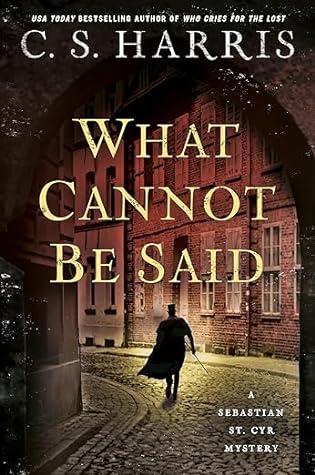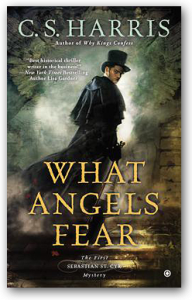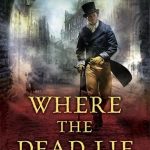 What Cannot Be Said (Sebastian St. Cyr, #19) by C.S. Harris
What Cannot Be Said (Sebastian St. Cyr, #19) by C.S. Harris Format: eARC
Source: supplied by publisher via Edelweiss
Formats available: hardcover, large print, ebook, audiobook
Genres: regency mystery
Series: Sebastian St. Cyr #19
Pages: 368
Published by Berkley on April 16, 2024
Purchasing Info: Author's Website, Publisher's Website, Amazon, Barnes & Noble, Kobo, Bookshop.org, Better World Books
Goodreads
A seemingly idyllic summer picnic ends in a macabre murder that echoes a pair of slayings fourteen years earlier in this riveting new historical mystery from the USA Today bestselling author of Who Cries for the Lost.
July 1815: The Prince Regent’s grandiose plans to celebrate Napoléon’s recent defeat at Waterloo are thrown into turmoil when Lady McInnis and her daughter Emma are found brutally murdered in Richmond Park, their bodies posed in a chilling imitation of the stone effigies once found atop medieval tombs. Bow Street magistrate Sir Henry Lovejoy immediately turns to his friend Sebastian St. Cyr, Viscount Devlin, for help with the investigation. For as Devlin discovers, Lovejoy’s own wife and daughter were also murdered in Richmond Park, their bodies posed in the same bizarre postures. A traumatized ex-soldier was hanged for their killings. So is London now confronting a malicious copyist? Or did Lovejoy help send an innocent man to the gallows?
Aided by his wife, Hero, who knew Lady McInnis from her work with poor orphans, Devlin finds himself exploring a host of unsavory characters from a vicious chimney sweep to a smiling but decidedly lethal baby farmer. Also coming under increasing scrutiny is Sir Ivo McInnis himself, along with a wounded Waterloo veteran—who may or may not have been Laura McInnis’s lover—and a charismatic young violinist who moonlights as a fencing master and may have formed a dangerous relationship with Emma. But when Sebastian’s investigation turns toward man about town Basil Rhodes, he quickly draws the fury of the Palace, for Rhodes is well known as the Regent’s favorite illegitimate son.
Then Lady McInnis’s young niece and nephew are targeted by the killer, and two more women are discovered murdered and arranged in similar postures. With his own life increasingly in danger, Sebastian finds himself drawn inexorably toward a conclusion far darker and more horrific than anything he could have imagined.
My Review:
Most readers, myself included, read mysteries for what one author has called “the romance of justice”. What we love about the genre is that no matter how dark the deed, the investigator is able to figure out ‘whodunnit’, justice triumphs and evil receives its just desserts, followed by the reader’s catharsis that order has been restored to the world.
That’s not what happens in this case – because it can’t. This is a case where there can be no justice. Even though the investigator does manage to figure out ‘whodunnit’ there is no catharsis to be had and it would be wrong if there were.
Two bodies are discovered in Richmond Park, a mother and her 16-year-old daughter. That they are cut down in the prime of – or even worse at the beginning of – their lives is unjust enough. Then the situation gets worse.
The bodies are posed in repose, in exactly the same way that the bodies of another mother and daughter were found in that same park, near that same spot, fourteen years previously. It’s the grief over the deaths of his wife and daughter that put Magistrate Henry Lovejoy on the road that led to his first case with Viscount Devlin nearly a decade later, and could be said to have changed both their lives.
Seeing these two bodies – so like his own wife and daughter – make Lovejoy question whether in his zeal to bring SOMEONE to justice all those years ago he pushed for the wrong man’s conviction and execution. In his reinvigorated grief, his crisis of conscience is profound. Yet he still soldiers on in a case that he should have passed on to another Magistrate. Because someone else might get it wrong – as he might have fourteen years ago. He has to see this through – even if – or especially because – he may have apologies owing now, at the end, that won’t begin to redress the damage he caused at the beginning.
Devlin has a crisis of another kind, as the more he delves into this case, both the past tragedy and the present conundrum, the less ANY of it makes sense. The mother had enemies. The daughter had indiscretions. There are plenty of people with motive to kill the mother and even a few who might wish to eliminate the daughter but seemingly no one with this deep an animus for them both – although the husband/father certainly comes closest. As those closest to the victim or victims often do.
It’s only when Devlin sets aside his initial assumptions that logic forces him to reckon with the maxim later attributed to Sherlock Holmes, that “when you have eliminated all which is impossible, then whatever remains, however improbable, must be the truth.” In this case, a truth that is so heinous, so previously unthinkable, that no one who confronts it with him can even conceive of a just punishment.
But one desperate man can see – if not justice – at least an ending.
 Escape Rating A+: This was, as is usual for my reading in this series, a one-night read that wouldn’t let go of me until it was over. Which doesn’t mean that I’m over it. Sebastian St. Cyr, Viscount Devlin, certainly was not at the story’s end.
Escape Rating A+: This was, as is usual for my reading in this series, a one-night read that wouldn’t let go of me until it was over. Which doesn’t mean that I’m over it. Sebastian St. Cyr, Viscount Devlin, certainly was not at the story’s end.
One of the things that has always fascinated me about this series is the way that even though the murder is always solved, the amount of justice available to be served along with that solution is always limited.
Not that this era didn’t punish its criminals harshly – and as is often shown during the course of the series – unjustly. Rather, it’s that Devlin investigates crimes among the highest and mightiest, and as the saying has always gone, “the rich are different from you and me”.
In other words, Devlin often finds himself in the middle of cases where many of the suspects and even the perpetrators are above the law and protected, as is the case of one suspect here, by someone even higher.
Also, in investigating the dark and dirty underbelly of the glittering Regency, Devlin all too often finds practices that, while perfectly legal, turn both his stomach and ours. As is true in this particular case, as his wife, as well as the murder victim, were pushing hard for reforms in the commonly abused apprentice system – not to mention the vile practice of baby farming – and ruffling plenty of important feathers along their reforming way.
That feather ruffling could have been a motive for one of the murders, but not both. A big part of what keeps the reader turning pages in this one is watching the normally indefatigable and unflappable Devlin flag and flap because the pieces of this puzzle don’t add up – not even badly.
And not that we ALL don’t hope that the husband did it and that Devlin can make THAT stick. Alas, that hope is in vain – which is good for the story in a peculiar way because that would have made things much too easy and considerably less unsettling for both Devlin and the reader.
In the end, this is a story about bringing the unthinkable into thought, and just how much justice is even possible in a case that is indubitably true that absolutely no one will want to believe. Those are hard questions, and they are just as valid in contemporary mystery as they are in this historical iteration.
This series, centered on the riveting character of Sebastian St. Cyr, Viscount Devlin, and the equally compelling cast of friends and enemies – definitely the enemies! – that have gathered around him and his “poking his nose into situations where many believe it does not belong” has had this reader caught in its unshakeable grip since that very first book, What Angels Fear, so very long ago. The fascination hasn’t let go yet, and I don’t expect it to.
What I, maybe not expect but certainly hope for, is yet another page-turning story in the Sebastian St. Cyr series, hopefully this time next year!



















